Enterprise takes another test drive
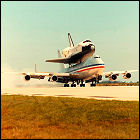 Mounted on the back of Boeing 747, the Space Shuttle Enterprise takes off on its first crewed flight, the first of three “captive-active” flights which see Enterprise remain in place on its carrier aircraft. For the first time, Enterprise’s computers, avionics and other flight systems are powered up in a full-up, hour-long dress rehearsal of an eventual free-flight landing test at 15,000 feet. The first crew of the Space Shuttle Enterprise consists of astronauts Fred Haise and Gordon Fullerton.
Mounted on the back of Boeing 747, the Space Shuttle Enterprise takes off on its first crewed flight, the first of three “captive-active” flights which see Enterprise remain in place on its carrier aircraft. For the first time, Enterprise’s computers, avionics and other flight systems are powered up in a full-up, hour-long dress rehearsal of an eventual free-flight landing test at 15,000 feet. The first crew of the Space Shuttle Enterprise consists of astronauts Fred Haise and Gordon Fullerton.
Space Cooperation Agreement renewed
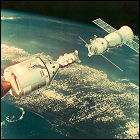 With the 1972 agreement having resulted in the successful Apollo-Soyuz Test Project, the United States and the Soviet Union formally renew the Space Cooperation Agreement. As an immediate goal to build on Apollo-Soyuz, both countries hold tentative discussions about docking the American Space Shuttle (which, it is still assumed, will be in space before the 1970s are out) and a Soviet Salyut space station. Though the shuttle’s first flight is still being delayed, the biggest hurdle will prove to be international relations, specifically a renewed chilling of the Cold War thanks to the Soviet Union’s 1979 invasion of Afghanistan.
With the 1972 agreement having resulted in the successful Apollo-Soyuz Test Project, the United States and the Soviet Union formally renew the Space Cooperation Agreement. As an immediate goal to build on Apollo-Soyuz, both countries hold tentative discussions about docking the American Space Shuttle (which, it is still assumed, will be in space before the 1970s are out) and a Soviet Salyut space station. Though the shuttle’s first flight is still being delayed, the biggest hurdle will prove to be international relations, specifically a renewed chilling of the Cold War thanks to the Soviet Union’s 1979 invasion of Afghanistan.
Enterprise test drive
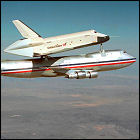 Mated to its Boeing 747 Shuttle Carrier Aircraft, Space Shuttle Enterprise goes airborne for the first time in the first of a series of “captive-inert” test flights. During these flights, there is no crew aboard Enterprise, nor are any of the test shuttle’s systems powered up; the flights are intended to make sure that the combination of the 747 and the Enterprise is capable of being flown safely. Further “captive-inert” flights are carried out over a ten-day period.
Mated to its Boeing 747 Shuttle Carrier Aircraft, Space Shuttle Enterprise goes airborne for the first time in the first of a series of “captive-inert” test flights. During these flights, there is no crew aboard Enterprise, nor are any of the test shuttle’s systems powered up; the flights are intended to make sure that the combination of the 747 and the Enterprise is capable of being flown safely. Further “captive-inert” flights are carried out over a ten-day period.
Enterprise hails a taxi
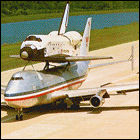 Space Shuttle Enterprise, mated to the heavily-modified Boeing 747 Shuttle Carrier Aircraft (SCA) for the first time, undergoes three “taxi tests” to enusre the structural stability of the two-vehicle combination on the runway before they ever take off. This is the first phase of a series of tests that will culminate, later in 1977, in a series of brief unpowered flights and landing tests using the Enterprise, verifying the shuttle’s gliding aerodynamics.
Space Shuttle Enterprise, mated to the heavily-modified Boeing 747 Shuttle Carrier Aircraft (SCA) for the first time, undergoes three “taxi tests” to enusre the structural stability of the two-vehicle combination on the runway before they ever take off. This is the first phase of a series of tests that will culminate, later in 1977, in a series of brief unpowered flights and landing tests using the Enterprise, verifying the shuttle’s gliding aerodynamics.
Enterprise leaves drydock
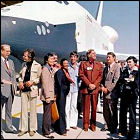 On schedule, the Space Shuttle Enterprise is rolled out of the Rockwell International plant in Palmdale, California to much public fanfare, a ceremony including Star Trek creator Gene Roddenberry and most of the cast who played the crew of the Enterprise’s fictional namesake (William Shatner was conspicuously absent). The timing of the rollout, ironically, was intended to roll the test shuttle – originally named Constitution – out of the hangar on Constitution Day during the bicentennial year.
On schedule, the Space Shuttle Enterprise is rolled out of the Rockwell International plant in Palmdale, California to much public fanfare, a ceremony including Star Trek creator Gene Roddenberry and most of the cast who played the crew of the Enterprise’s fictional namesake (William Shatner was conspicuously absent). The timing of the rollout, ironically, was intended to roll the test shuttle – originally named Constitution – out of the hangar on Constitution Day during the bicentennial year.
STA-099
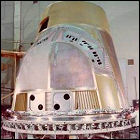 Construction begins on Space Shuttle Structural Test Article 099 (STA-099), a full-sized structural model of the shuttle built for stress and thermal testing. Four years later, NASA decides to abandon plans to refit the test shuttle Enterprise for space duty at great expense, instead opting to upgrade the STA-099 airframe into a spaceworthy vehicle, which will eventually be named Challenger. While the refit will still be expensive, it takes less time and money than a complete teardown and rebuild of Enterprise’s airframe, which was never intended for flight outside the atmosphere.
Construction begins on Space Shuttle Structural Test Article 099 (STA-099), a full-sized structural model of the shuttle built for stress and thermal testing. Four years later, NASA decides to abandon plans to refit the test shuttle Enterprise for space duty at great expense, instead opting to upgrade the STA-099 airframe into a spaceworthy vehicle, which will eventually be named Challenger. While the refit will still be expensive, it takes less time and money than a complete teardown and rebuild of Enterprise’s airframe, which was never intended for flight outside the atmosphere.
Columbia under construction
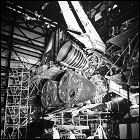 Construction begins on Space Shuttle Orbiter Vehicle 102 (OV-102 for short), the shuttle orbiter that NASA intends to launch as early as 1977. But OV-102 encounters the inherent pitfalls of being the first of its kind: years of delays are ahead, with many of the delays linked to the complicated system of protective thermal tiles designed to bear the brunt of the shuttle’s punishing re-entry through the atmosphere. (The test orbiter, later named Enterprise, is never intended for spaceflight, so it only has to conform to the shape and weight of a returning shuttle for landing tests, and therefore it doesn’t face the same hurdles.) OV-102’s first flight won’t take place until 1981, leaving a six-year gap between manned American spaceflights; during this period OV-102 will be named Columbia.
Construction begins on Space Shuttle Orbiter Vehicle 102 (OV-102 for short), the shuttle orbiter that NASA intends to launch as early as 1977. But OV-102 encounters the inherent pitfalls of being the first of its kind: years of delays are ahead, with many of the delays linked to the complicated system of protective thermal tiles designed to bear the brunt of the shuttle’s punishing re-entry through the atmosphere. (The test orbiter, later named Enterprise, is never intended for spaceflight, so it only has to conform to the shape and weight of a returning shuttle for landing tests, and therefore it doesn’t face the same hurdles.) OV-102’s first flight won’t take place until 1981, leaving a six-year gap between manned American spaceflights; during this period OV-102 will be named Columbia.
Shuttle schedule slippage
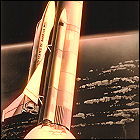 With the final Apollo spacecraft’s flight mere months away, an internal NASA document examining the progress of the Space Shuttle program, approved in 1972 by President Nixon, spells out what seems like a worst-case scenario: thanks to the difficulties of creating whole new orders of technology to create a reusable space vehicle (on a budget which each successive Congress keeps slashing), the shuttle won’t be lifting off until 1979 at the earliest, leaving a potential four-year gap in American crewed spaceflight when NASA was anticipating (and publicizing) a gap of no more than two years. (In actuality, the time between crewed American space missions will be even longer than that.)
With the final Apollo spacecraft’s flight mere months away, an internal NASA document examining the progress of the Space Shuttle program, approved in 1972 by President Nixon, spells out what seems like a worst-case scenario: thanks to the difficulties of creating whole new orders of technology to create a reusable space vehicle (on a budget which each successive Congress keeps slashing), the shuttle won’t be lifting off until 1979 at the earliest, leaving a potential four-year gap in American crewed spaceflight when NASA was anticipating (and publicizing) a gap of no more than two years. (In actuality, the time between crewed American space missions will be even longer than that.)
Enterprise in drydock
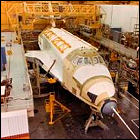 Construction begins on OV-101, a Space Shuttle intended for extensive atmospheric test flight and landings without ever going into space. Originally intended to bear the name Constitution, a letter-writing campaign by Star Trek fans convinces President Gerald Ford to request that NASA rename the first shuttle Enterprise. Much of the first shuttle’s structural details are simply dummy models of the correct shape and weight; her engines are never intended to fire. Though plans are drawn up to convert Enterprise into a space-worthy vehicle, they are never carried out: it’s deemed cheaper and faster to upgrade a structural test model of the shuttle instead.
Construction begins on OV-101, a Space Shuttle intended for extensive atmospheric test flight and landings without ever going into space. Originally intended to bear the name Constitution, a letter-writing campaign by Star Trek fans convinces President Gerald Ford to request that NASA rename the first shuttle Enterprise. Much of the first shuttle’s structural details are simply dummy models of the correct shape and weight; her engines are never intended to fire. Though plans are drawn up to convert Enterprise into a space-worthy vehicle, they are never carried out: it’s deemed cheaper and faster to upgrade a structural test model of the shuttle instead.
Apollo: the Shuttle’s lifeboat?
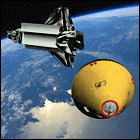 Space shuttle contractor North American Rockwell submits a safety study to NASA concerning safety and escape systems for the upcoming space shuttle, including a study of smaller vehicles with potential use as “lifeboats” in the event that a shuttle is unfit for return to Earth due to heat shield or other catastrophic damage. The various proposals, which include the possibility of permanently berthing an Apollo command module (another vehicle contracted to North American Rockwell) in the shuttle’s cargo bay for use as a lifeboat, are rejected by NASA due to the impact that each proposal would have on available space and weight for cargo.
Space shuttle contractor North American Rockwell submits a safety study to NASA concerning safety and escape systems for the upcoming space shuttle, including a study of smaller vehicles with potential use as “lifeboats” in the event that a shuttle is unfit for return to Earth due to heat shield or other catastrophic damage. The various proposals, which include the possibility of permanently berthing an Apollo command module (another vehicle contracted to North American Rockwell) in the shuttle’s cargo bay for use as a lifeboat, are rejected by NASA due to the impact that each proposal would have on available space and weight for cargo.
Solid rocket boosters picked for shuttle
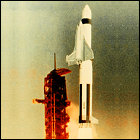 After a five-month design study focusing on alternatives to a winged (and manned) reusable first stage bosoter for the upcoming Space Shuttle, NASA settles on a configuration consisting of two solid rocket boosters strapped to the shuttle’s external fuel tank. Among the alternatives considered was the possibility of restarting production of the Saturn V rockets that launched Apollo and Skylab missions, with the shuttle and its fuel tank separating from the Saturn V’s first stage at high altitude (though in this configuration, a failure of the shuttle’s main engines would prove to be catastrophic). The SRB/tank configuration is expected to shave half a billion dollars off of the shuttle’s development costs.
After a five-month design study focusing on alternatives to a winged (and manned) reusable first stage bosoter for the upcoming Space Shuttle, NASA settles on a configuration consisting of two solid rocket boosters strapped to the shuttle’s external fuel tank. Among the alternatives considered was the possibility of restarting production of the Saturn V rockets that launched Apollo and Skylab missions, with the shuttle and its fuel tank separating from the Saturn V’s first stage at high altitude (though in this configuration, a failure of the shuttle’s main engines would prove to be catastrophic). The SRB/tank configuration is expected to shave half a billion dollars off of the shuttle’s development costs.
The Space Transportation System
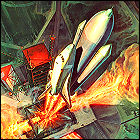 President Richard Nixon announces that, after three years of studies, design concepts, and deliberations, he has given NASA the go-ahead to develop a reusable space vehicle, the Space Shuttle, which can perform multiple mission profiles, land safely and launch again, with the eventual goal of launching a shuttle almost every week of the year. The contract to build the shuttle is awarded to Apollo command/service module contractor North American Aviation, which is later to complete a merger with Rockwell International, which assumes the task of building the shuttles. The first launch date is projected to take place at some point in the mid-to-late 1970s.
President Richard Nixon announces that, after three years of studies, design concepts, and deliberations, he has given NASA the go-ahead to develop a reusable space vehicle, the Space Shuttle, which can perform multiple mission profiles, land safely and launch again, with the eventual goal of launching a shuttle almost every week of the year. The contract to build the shuttle is awarded to Apollo command/service module contractor North American Aviation, which is later to complete a merger with Rockwell International, which assumes the task of building the shuttles. The first launch date is projected to take place at some point in the mid-to-late 1970s.
Shuttle thermal protection system chosen
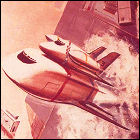 Potential contractors for NASA’s upcoming Space Shuttle offer specs based on their final design studies, which still assume that the shuttle’s giant booster will be a manned, winged vehicle in its own right that will return to a runway on Earth after its fuel is used up. One thing that both studies suggest, however, is an aluminum airframe which requires a shift away from the ablative metallic heat shields of the Mercury, Gemini and Apollo programs. A system of carbon-reinforced “shingles” is suggested as an alternative, and is approved by NASA, though developing the technology to create, install and maintain these tiles delays the first Shuttle launch into the 1980s, and the tiles are still prone to damage during both launch and re-entry – a weakness that will eventually seal the end of the Space Shuttle era.
Potential contractors for NASA’s upcoming Space Shuttle offer specs based on their final design studies, which still assume that the shuttle’s giant booster will be a manned, winged vehicle in its own right that will return to a runway on Earth after its fuel is used up. One thing that both studies suggest, however, is an aluminum airframe which requires a shift away from the ablative metallic heat shields of the Mercury, Gemini and Apollo programs. A system of carbon-reinforced “shingles” is suggested as an alternative, and is approved by NASA, though developing the technology to create, install and maintain these tiles delays the first Shuttle launch into the 1980s, and the tiles are still prone to damage during both launch and re-entry – a weakness that will eventually seal the end of the Space Shuttle era.
NASA solicits shuttle, station proposals
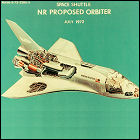 NASA formally asks various major players in the aerospace industry for proposals for what the agency sees as its two major projects for the 1970s: an orbiting space station and a reusable Space Shuttle to make routine flights from Earth to the station – which NASA hopes will be a “50 man space base” – and back again, with supplies, experiments, and new crew members. (Within mere weeks, the hypothetical station’s equally hypothetical crew will be downsized to a dozen.) In the event that the development curve on the Space Shuttle proves to be a long one, NASA says it will keep Apollo and even Gemini spacecraft in service to make flights to the station.
NASA formally asks various major players in the aerospace industry for proposals for what the agency sees as its two major projects for the 1970s: an orbiting space station and a reusable Space Shuttle to make routine flights from Earth to the station – which NASA hopes will be a “50 man space base” – and back again, with supplies, experiments, and new crew members. (Within mere weeks, the hypothetical station’s equally hypothetical crew will be downsized to a dozen.) In the event that the development curve on the Space Shuttle proves to be a long one, NASA says it will keep Apollo and even Gemini spacecraft in service to make flights to the station.
Vehicle Assembly Building open for business
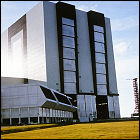 NASA’s massive Vehicle Assembly Building is completed at the spaceport rapidly taking shape on Cape Canaveral ahead of the Apollo lunar missions. Topped off at a total cost of $117,000,000, the VAB is where Saturn V rockets are assembled for the Apollo moonshots, and the huge, eight-acre building will later transition to the assembly of the Space Shuttle launch system elements and the Space Launch System boosters for the 21st century Orion program.
NASA’s massive Vehicle Assembly Building is completed at the spaceport rapidly taking shape on Cape Canaveral ahead of the Apollo lunar missions. Topped off at a total cost of $117,000,000, the VAB is where Saturn V rockets are assembled for the Apollo moonshots, and the huge, eight-acre building will later transition to the assembly of the Space Shuttle launch system elements and the Space Launch System boosters for the 21st century Orion program.
The Vehicle Assembly Building
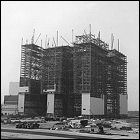 Construction commences on NASA’s massive Vehicle Assembly Building (originally named the Vertical Assembly Building), where the giant Saturn V rockets for Apollo lunar missions will be constructed, tested, and then rolled out to the launch pad atop huge mobile crawlers. Covering eight acres of land on Merritt Island, Florida, the building must withstand Florida’s notorious hurricane seasons (and protect any rockets under construction within) as well as the shockwaves of Saturn V rocket launches taking place only three miles away; special ventilation and humidity control systems have to be built as well, as the interior space is so voluminous that the building has its own internal weather! The VAB will later transition to the assembly of the Space Shuttle launch system elements and the Space Launch System boosters for the 21st century Orion program.
Construction commences on NASA’s massive Vehicle Assembly Building (originally named the Vertical Assembly Building), where the giant Saturn V rockets for Apollo lunar missions will be constructed, tested, and then rolled out to the launch pad atop huge mobile crawlers. Covering eight acres of land on Merritt Island, Florida, the building must withstand Florida’s notorious hurricane seasons (and protect any rockets under construction within) as well as the shockwaves of Saturn V rocket launches taking place only three miles away; special ventilation and humidity control systems have to be built as well, as the interior space is so voluminous that the building has its own internal weather! The VAB will later transition to the assembly of the Space Shuttle launch system elements and the Space Launch System boosters for the 21st century Orion program.